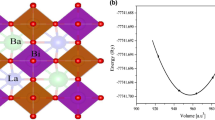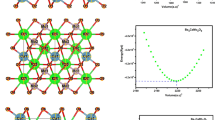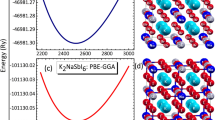Abstract
Context
This research paper investigates the properties and potential applications of antiperovskite materials. Antiperovskites are a class of materials with a unique crystal structure, where the central atom is surrounded by a cage of anions. We review recent research on antiperovskite-based materials for energy storage, photovoltaics, catalysis, and sensors. We discovered that these materials display direct band gap semiconductors, strong absorption in the visible (VIS), ultra-violet (UV), and near infrared regions (NIR) based on their fundamental features, which is the most admirable quality that may be found in many optoelectronic devices. Both mechanical and thermodynamic stability have been confirmed for these materials. We discovered that these materials exhibit high figures of merit through the calculation of transport properties, which makes them a promising candidate for thermoelectric devices. It is anticipated that the proposed material BiPMg3, which has a theoretical efficiency of 11.5%, will make a suitable photovoltaic absorber. This paper highlights the potential of these materials for future technological advancements.
Methods
Herein, we have used most authentic techniques to compute fundamental physical properties of these antiperovskites. Full-potential linear augmented plane wave (FP-LAPW) method has been used to investigate electronic, magnetic, optical properties, and make antiperovskites attractive for a variety of applications. In light of its implementation, we have checked the theoretical power conversion efficiency by first principles spectroscopic screening methodology, and inspect the fundamental physical parameters of antiperovskites, focusing on their potential as functional materials for energy and information technologies.














Similar content being viewed by others
Data availability
Data and materials will be available on reasonable request.
References
Kang Y, Han S (2020) Antiperovskite oxides as promising candidates for high-performance ferroelectric photovoltaics: first-principles investigation on Ba4As2O and Ba4Sb2O. ACS Appl Mater Interfaces 12:43798–43804
Heinselman KN, Lany S, Perkins JD, Talley KR, Zakutayev A (2019) Thin film synthesis of semiconductors in the Mg–Sb–N materials system. Chem Mater 31:8717–8724
Liu Z, Mi R, Ji G, Liu Y, Fu P, Hu S, Zia B, Xiao Z (2021) Bandgap engineering and thermodynamic stability of oxyhalide and chalcohalide antiperovskites. Ceram Int 47:32634–32640
Bessimou M, Masrour R, Jabar A, Kadim G, Hlil EK (2022) Density functional theory and Monte Carlo study of electronic, magnetic and magnetocaloric properties of Fe3CoN and FeCo3N antiperovskites. J Cryst Growth 581:126497
Goh WF, Pickett WE (2020) Topological and thermoelectric properties of double antiperovskite pnictides. J Phys Condens Matter 32:345502
Okamoto Y, Sakamaki A, Takenaka K (2016) Thermoelectric properties of antiperovskite calcium oxides Ca3PbO and Ca3SnO. J Appl Phys 119:205106
Rani U, Kamlesh PK, Agarwal R, Kumari J, Verma AS (2021) Electronic and thermo- physical properties of double antiperovskites X6SOA2 (X= Na, K and A= Cl, Br, I): a non-toxic and efficient energy storage materials. Int J Quantum Chem 121:e26759
Deng Z, Ni D, Chen D, Bian Y, Li S, Wang Z, Zhao Y (2022) Anti-perovskite materials for energy storage batteries. InfoMat 4:e12252
Dawson JA, Famprikis T, Johnston KE (2021) Anti-perovskites for solid-state batteries: recent developments, current challenges, and future prospects. J Mater Chem A 9:18746–18772
Rani U, Soni Y, Kamlesh PK, Pachori S, Verma AS (2021) Fundamental theoretical design of Na-ion and K-ion based double antiperovskite X6SOA2 (X= Na, K; A= Cl, Br, and I) halides: potential candidate for energy storage and harvester. Int J Energy Res 45:13442–13460
Kamishima K, Goto T, Nakagawa H, Miura N, Ohashi M, Mori N, Sasaki T, Kanomata T (2000) Giant magnetoresistance in the intermetallic compound Mn3GaC. Phys Rev B 63:024426
Wang S, Tong P, Sun YP, Li LJ, Tang W, Lu WJ, Zhu XB, Yang ZR, Song WH (2009) Enhanced giant magnetoresistance in Ni-doped antipervoskite compounds GaCMn3xNix (x = 0.05, 0.10). Appl Phys Lett 95:222509
Yu MH, Lewis LH, Moodenbaugh AR (2003) Large magnetic entropy changes in the metallic antiperovskite Mn3GaC. J Appl Phys 93:10128
Wang S, Tong P, Sun YP, Luo X, Zhu XB, Li G, Zhu XD, Zhang SB, Yang ZR, Song WH, Dai JM (2009) Large magnetic entropy change near room temperature in antiperovskite SnCMn3. EPL 85:47004
Iikubo S, Kodama K, Takenaka K, Takagi H, Takigawa M, Shamoto S (2008) Local lattice distortion in the giant negative thermal expansion material Mn3Cu1-xGexN. Phys Rev Lett 101:205901
Takenaka K, Takagi H (2009) Zero thermal expansion in a pure-form antiperovskite manganese nitride. Appl Phys Lett 94:131904
Asano K, Koyama K, Takenaka K (2008) Magnetostriction in Mn3CuN. Appl Phys Lett 92:161909
Hassan M, Shahid A, Mahmood Q (2018) Structural, electronic, optical and thermoelectric investigations of antiperovskites A3SnO (A = Ca, Sr, Ba) using density functional theory. Solid State Commun 270:92–98
Goh WF, Pickett WE (2018) Survey of the class of isovalent antiperovskite alkaline-earth pnictide compounds. Phys Rev B 97:035202
Chern MY, Vennos DA, DiSalvo FJ (1992) Synthesis, structure, and properties of antiperovskite nitrides Ca3MN (M = P, As, Sb, Bi, Ge, Sn, and Pb). J Solid State Chem 96:415–425
Vansant PR, Camp PEV, Doren VEV (1998) Variable cell shape based structural optimization applied to calcium nitrides. Phys Rev B 57:7615–7620
Moakafi M, Khenata R, Bouhemadou A, Semari F, Reshak AH, Rabah M (2009) Elastic, electronic and optical properties of cubic antiperovskite SbNCa3 and BiNCa3. Comput Mater Sci 46:1051–1057
Castro ACG, Ospina R, Quintero JH (2020) Octahedral distortion and electronic properties of the antiperovskite oxide Ba3SiO: first-principles study. J Phys Chem Solids 136:109126
Choi HS, Kim WS, Kim JC, Hur NH (2002) Epitaxial growth of antiperovskite GaCMn3 film on perovskite LaAlO3 substrate. J Mater Res 17:2640–2643
Quintela CX, Campbell N, Shao DF, Irwin J, Harris DT, Xie L, Anderson TJ, Reiser N, Pan XQ, Tsymbal EY, Rzchowski MS, Eom CB (2017) Epitaxial thin films of Dirac semimetal antiperovskite Cu3PdN. APL Mater 5:096103
Minohara M, Yukawa R, Kitamura M, Kumai R, Murakami Y, Kumigashira H (2018) Growth of antiperovskite oxide Ca3SnO films by pulsed laser deposition. J Cryst Growth 500:33–37
Emly A, Kioupakis E, Ven AV (2013) Phase stability and transport mechanisms in antiperovskite Li3OCl and Li3OBr superionic conductors. Chem Mater 25:4663–4670
Beznosikov BV (2003) Predicted nitrides with an antiperovskite structure. J Struct Chem 44:885–888
Rani U, Kamlesh PK, Shukla A, Verma AS (2021) Emerging potential antiperovskite materials ANX3 (A= P, As, Sb, Bi; X= Sr, Ca, Mg) for thermoelectric renewable energy generators. J Solid State Chem 300:122246
Blaha P, Schwarz K, Madsen GKH, Kvasnicka D, Luitz J (2001) WIEN2K: an augmented plane wave + local orbitals program for calculating crystal properties. Karlheinz Schwarz/Techn. Universität Wien, Austria
Wu Z, Cohen RE (2006) More accurate generalized gradient approximation for solids. Phys Rev B 73:235116
Tran F, Blaha P (2009) Accurate band gaps of semiconductors and insulators with a semilocal exchange-correlation potential. Phys Rev Lett 102:226401
Madsen GKH, Singh DJ (2006) BoltzTraP. A code for calculating band-structure dependent quantities. Comput Phys Commun 175:67–71
Otero-de-la-Roza A, Abbasi-Pérez D, Luaña V (2011) Gibbs2: a new version of the quasiharmonic model code. II. Models for solid-state thermodynamics, features, and implementation. Comput Phys Commun 182:2232–2248
Kamlesh PK, Agarwal R, Rani U, Verma AS (2021) First-principles calculations of inherent properties of Rb-based state-of-the-art half-Heusler compounds: promising materials for renewable energy applications. Phys Scr 96:115802
Basit A, Khan SA, Murtaza G, Mehmood A, Khenata R, Omran SB, Yaseen M (2016) Electronic, optical and thermoelectric properties of XNMg3 (X= P, As, Sb, Bi) compounds. Mater Sci Semicond Process 43:69–74
Kamlesh PK, Pravesh, Kumari S, Verma AS (2020) Effect of hybrid density functionals on half–Heusler LiZnX (X = N, P and As) semiconductors: potential materials for photovoltaic and thermoelectric applications. Phys Scr 95:095806
Rani U, Kamlesh PK, Agrawal R, Shukla A, Verma AS (2022) Emerging study on lead-free hybrid double perovskite (CH3NH3)2AgInBr6: potential material for energy conversion between heat and electricity. Energ Technol 10:2200002
Sarfraz S, Aldaghfag SA, Butt MK, Yaseen M, Zahid M, Dahshan A (2022) Physical properties of KTaO3 compound for optoelectronic and thermoelectric applications: a DFT study. Mater Sci Semicond Process 148:106811
Kamlesh PK, Agrawal R, Rani U, Verma AS (2022) Comprehensive ab-initio calculations of AlNiX (X = P, As and Sb) half-Heusler compounds: stabilities and applications as green energy resources. Mater Chem Phys 275:125233
Al-Qaisi S, Ali MA, Alrebdi TA, Vu TV, Morsi M, UlHaq B, Ahmed R, Mahmood Q, Tahir SA (2022) First-principles investigations of Ba2NaIO6 double Perovskite semiconductor: material for low-cost energy technologies. Mater Chem Phys 275:125237
Pugh S XCII (1954) Relations between the elastic moduli and the plastic properties of polycrystalline pure metals. Lond Edinb Dublin Philos Mag J Sci 45:823–843
Pettifor D (1992) Theoretical predictions of structure and related properties of intermetallics. Mater Sci Technol 8:345–349
Vaitheeswaran G, Kanchana V, Svane A, Delin A (2007) Elastic properties of MgCNi3 – a superconducting perovskite. J Phys Condens Matter 19:326214
Otero-de-la-Roza A, Abbasi-Pérez D, Luaña V (2011) Gibbs2: a new version of the quasiharmonic model code. II. Models for solid-state thermodynamics, features, and implementation. Comput Phys Commun 182(10):2232–2248
Francisco E, Blanco MA, Sanjurjo G (2001) Atomistic simulation of SrF2 polymorphs. Phys Rev B 63:094107
Pallavi, Singh C, Kamlesh PK, Kaur K, Verma AS (2023) Nowotny-Juza phase KBeX (X = N, P, As, Sb, and Bi) half-Heusler compounds: applicability in photovoltaics and thermoelectric generators. J Mol Model 29:23
Peng X, Xing L, Fang Z (2007) Comparing research on the pressure or volume dependence of Grüneisen parameter. Physica B Condens Matter 394:111–114
Yu L, Zunger A (2012) Identification of potential photovoltaic absorbers based on first-principles spectroscopic screening of materials. Phys Rev Lett 108:068701
Bercx M, Saniz R, Partoens B, Lamoen D (2018) Exceeding the Shockley–Queisser limit within the detailed balance framework In: Angilella G, Amovilli C (eds) Many-body approaches at different scales. Cham, p 177–184
Bercx M, Sarmadian N, Saniz R, Partoens B, Lamoen D (2016) First-principles analysis of the spectroscopic limited maximum efficiency of photovoltaic absorber layers for CuAu-like chalcogenides and silicon. PCCP 18:20542–20549
Joshi TK, Shukla A, Sharma G, Verma AS (2021) First-principles spectroscopic screening of hybrid perovskite (CH3CH2NH3PbI3) with fundamental physical properties: a potential photovoltaic absorber. Int J Energy Res 45:908–919
Joshi TK, Shukla A, Sharma G, Verma AS (2021) Emerging potential photovoltaic absorber hybrid halide perovskites (CH3CH2NH3PbX3; X= Br, Cl) materials: an ab-initio calculation. Int J Energy Res 45:15231–15244
Anderson OL, Demarest HH Jr (1971) Elastic constants of the central force model for cubic structures: polycrystalline aggregates and instabilities. J Geophys Res 76:1349–1369
Hadi M (2020) Superconducting phases in a remarkable class of metallic ceramics. J Phys Chem Solid 138:109275
Seddik T, Uğur G, Soyalp F, Khenata R, Prakash D, Kityk I, Khan SA, Bouhemadou A, Bin-Omran S, Rai D (2017) Computational investigations on band structure and electronic features of chromium-based carbides and nitride Cr3PX (X= C and N) through the FP-APW+ LO approach. Superlattice Microst 109:1–12
Author information
Authors and Affiliations
Contributions
Upasana Rani: Investigation, writing original draft. Peeyush Kumar Kamlesh: Methodology. Tarun Kumar Joshi: Software. Rashmi Singh: Data curation. Samah Al-Qaisi: Visualization; Validation. Rajeev Gupta: Conceptualization. Tanuj Kumar: Resources. Ajay Singh Verma: Supervision; Writing- Reviewing and Editing.
Corresponding author
Ethics declarations
Ethical approval
Not applicable on this work.
Competing interests
The authors declare no competing interests.
Additional information
Publisher's Note
Springer Nature remains neutral with regard to jurisdictional claims in published maps and institutional affiliations.
Rights and permissions
Springer Nature or its licensor (e.g. a society or other partner) holds exclusive rights to this article under a publishing agreement with the author(s) or other rightsholder(s); author self-archiving of the accepted manuscript version of this article is solely governed by the terms of such publishing agreement and applicable law.
About this article
Cite this article
Rani, U., Kamlesh, P.K., Joshi, T.K. et al. Electronic structure, theoretical power conversion efficiency, and thermoelectric properties of bismuth-based alkaline earth antiperovskites. J Mol Model 29, 329 (2023). https://doi.org/10.1007/s00894-023-05732-z
Received:
Accepted:
Published:
DOI: https://doi.org/10.1007/s00894-023-05732-z




